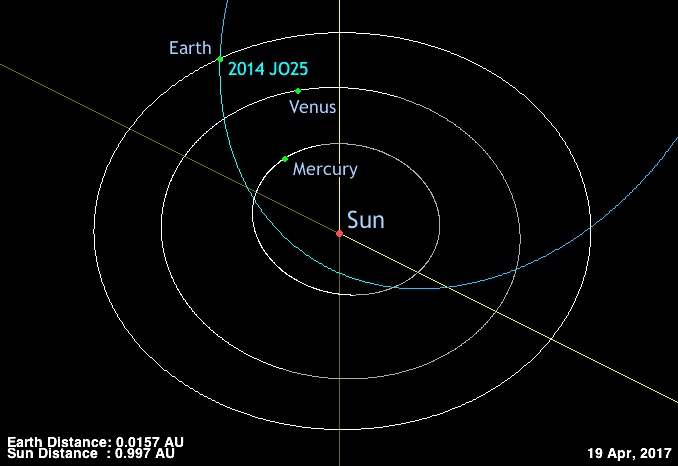A 650-metre-wide asteroid discovered three years ago by the Catalina Sky Survey in Arizona as part of NASA’s Near-Earth Object (NEO) Observations Program passes within five lunar distances of Earth on 19 April — the closest any known space rock of this size has approached our planet since September 2004.
Discovered in May 2014 and subsequently named 2014 JO25, the asteroid passes just 0.01175 astronomical units (1.09 million miles, or 4.57 lunar distances) from Earth at 12:24 UT (1:24pm BST) on Wednesday, 19 April. As astronomical twilight fades to dark in the British Isles this night, the magnitude +10.7 mile-wide space rock tumbles through the constellation of Canes Venatici at almost 3 degrees per hour — bright enough for its motion against the background stars to be viewed in 4-inch (10cm aperture) telescopes and larger.
A line drawn from beta (β) through alpha (α) Canum Venaticorum (the latter is better known by the name Cor Caroli) and extended a further 6 degrees brings you to the position of 2014 JO25 shortly after 12am BST on 20 April when the asteroid is close to the meridian, favourably located for UK observers some 70 degrees above the southern horizon.
Next, 2014 JO25 passes 51 arcminutes — slightly less than the width of two full Moons — west of beta Comae Berenices at 3am BST on 20 April, so backyard telescopes magnifying 40x or less can see the magnitude +4.2 star and magnitude +10.8 asteroid within the same field of view. The last quarter Moon does not rise until 3:30am BST on 20 April as seen from the heart of the UK, so observers in the British Isles will have dark skies.
The asteroid’s 19 April encounter is the closest it has come to Earth for at least 400 years and will be its closest approach for at least the next 500 years. However, we only have to wait until 2027 for the next close brush with a sizeable space rock when 800-metre-wide asteroid 1999 AN10 skims by our planet at a distance similar to that of the Moon.
Source: http://bit.ly/2nYeTYy













